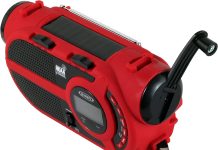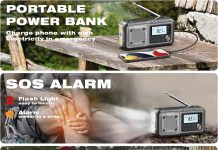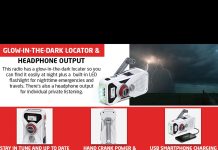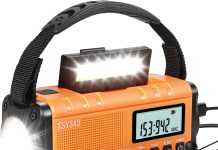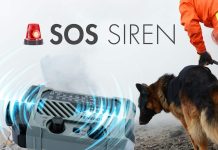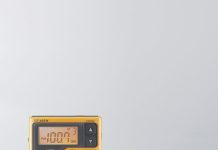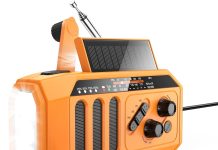Imagine being in a situation where communication is vital, and you urgently need help. In times like these, having a reliable method of communication becomes an absolute necessity. That’s where CB radios come into play. Whether you find yourself lost in the wilderness or facing a natural disaster, CB radios can prove to be your lifeline, connecting you to others who can lend a helping hand. In this article, we’ll explore the effectiveness of CB radios in emergencies, shedding light on how they can be an invaluable tool in times of crisis. So, let’s delve into the world of CB radios and discover why they may just save the day when it matters most!
Review contents
Advantages of CB Radios for Emergencies
Wide Coverage Area
One of the major advantages of CB radios for emergencies is their wide coverage area. CB radios operate on a specific frequency band that allows communication over long distances. In emergencies situations, where traditional communication networks may be down or overloaded, CB radios can provide a reliable means of communication, even in remote areas or areas with weak cellular coverage. This wide coverage area can be critical in times of crisis when reaching out for help or coordinating rescue efforts is vital.
No Dependence on Cellular Networks
Unlike cellular phones, CB radios do not rely on cellular networks to function. This is especially valuable during emergencies when cellular networks can become congested or fail altogether. In such situations, CB radios can continue to operate and facilitate communication between individuals. Whether it’s a natural disaster, a power outage, or a large-scale emergency event, you can rely on your CB radio to stay connected and stay informed.
Immediate and Direct Communication
During emergencies, every second counts. CB radios allow for immediate and direct communication, allowing for quick exchange of critical information. In emergency situations, being able to communicate directly with emergency responders, local authorities, or other individuals nearby can make all the difference in ensuring everyone’s safety and well-being. With a CB radio, you have a direct line of communication to share updates, request assistance, or coordinate rescue and relief efforts without any unnecessary delays.
Affordable and Widely Available
CB radios are not only affordable, but they are also widely available. You can find them in most electronics stores, online marketplaces, and even at truck stops. The affordability and accessibility of CB radios make them an excellent choice for individuals looking for an emergency communication solution that doesn’t break the bank. Compared to other communication devices, such as satellite phones or two-way radios, CB radios offer a cost-effective option without compromising on functionality or reliability.
Long Battery Life
Another advantage of CB radios for emergencies is their long battery life. Many CB radios are designed to operate efficiently and conserve power, ensuring that they can last for extended periods without needing frequent battery changes or recharging. This is especially useful in emergency situations when power sources might be limited or unavailable. The long battery life of CB radios ensures that you have a reliable means of communication throughout the duration of the emergency.
Simple Operation and Set-Up
CB radios are known for their simplicity in operation and set-up. Unlike more complex communication devices, CB radios are intuitive to use and require minimal technical knowledge. Most CB radios come with straightforward controls and easy-to-understand instructions, making them accessible for anyone, regardless of their technical proficiency. This ease of use is particularly advantageous during emergencies when time is of the essence and users need a communication device that can be quickly deployed and operated without any hassle.
Easy Communication with Truck Drivers
CB radios are widely used among truck drivers, creating a network of individuals who are often on the roads and have reliable access to communication. During emergencies, being able to communicate with truck drivers can be invaluable as they can provide real-time updates on road conditions, traffic, and any potential hazards or obstructions. This information can greatly assist emergency responders, aid in evacuation efforts, and enhance overall situational awareness. CB radios enable easy and direct communication with truck drivers, establishing a valuable link in emergency communication networks.
Weather Updates and Road Conditions
Many CB radios feature weather channels, allowing users to access up-to-date weather information and road conditions. During emergencies, knowing the latest weather updates is crucial for making informed decisions and ensuring personal safety. The weather channels on CB radios provide real-time updates on severe weather events, such as storms or tornadoes, enabling users to take appropriate precautions and respond effectively. Additionally, CB radios can provide road condition updates, informing users about any closures, accidents, or potential hazards along their routes.
Emergency Channels and Services
CB radios come equipped with dedicated emergency channels that enable users to access emergency services and assistance. These channels are monitored by emergency responders, law enforcement agencies, and volunteer organizations, ensuring immediate attention to distress calls and urgent situations. By tuning into these emergency channels, individuals can have direct communication with the appropriate authorities, relaying crucial information or requesting immediate assistance. This feature of CB radios enhances public safety and facilitates efficient emergency response.
Ability to Connect with Local Communities
During emergencies, it is essential to stay connected with the local community to gather important information and support one another. CB radios allow users to connect with local communities, providing a platform for sharing updates, seeking help, and offering assistance. Whether it’s through general chats, local club channels, or community-based networks, CB radios foster a sense of camaraderie and unity during times of crisis. This ability to establish a local network can be invaluable in coordinating relief efforts, locating missing individuals, and disseminating vital information within the community.
Limitations of CB Radios for Emergencies
Limited Range
While CB radios offer wide coverage, they do have limitations in terms of range. CB radios operate within a set range, typically limited to a few miles, depending on factors such as terrain and antenna height. In sprawling or mountainous regions, the effective range of CB radios may be significantly reduced, making long-distance communication challenging. It’s important to be aware of this limitation and understand that CB radios may not be suitable for emergency situations requiring communication over extensive distances.
Interference and Crowded Channels
CB radios operate on shared channels, which can often lead to interference and crowded communication. With multiple users transmitting simultaneously, it can be difficult to find an available channel that provides clear and uninterrupted communication. Additionally, CB radios are susceptible to interference from various sources, including nearby electrical devices or atmospheric conditions. This interference can disrupt communication and impact the effectiveness of CB radios in emergency situations.
Lack of Privacy and Security
CB radios are a form of public communication, and as such, lack the privacy and security features found in other communication devices. Conversations carried out on CB radios are potentially accessible to anyone within range who happens to be tuned in to the same frequency. This lack of privacy may not be ideal for emergency situations where sensitive or confidential information needs to be communicated. Moreover, the absence of encryption or authentication mechanisms in CB radios makes them vulnerable to unauthorized use or malicious interference.
No Text or Data Communication
Unlike cellular phones or other modern communication devices, CB radios solely support voice communication. They do not offer the capability for text-based messaging or data transmission. While this may not be a critical limitation during emergencies, the inability to send or receive text messages or data can restrict the exchange of detailed information or facilitate efficient coordination. This limitation should be considered when evaluating the suitability of CB radios for emergency communication needs.
Limited Emergency Services
While CB radios provide access to emergency channels and can connect users with emergency services, the range of available services may be limited compared to other communication devices. CB radios primarily rely on other CB radio users or emergency responders actively monitoring the channels. In remote areas or during large-scale emergencies, the availability of these services may be reduced, potentially hindering the ability to obtain prompt assistance or rescue.
Dependent on External Antennas
To maximize the range and performance of CB radios, external antennas are often required. Although CB radios come with built-in antennas, they may not be sufficient in certain situations, especially in areas with poor reception. Adding external antennas can significantly improve signal strength and overall performance. However, this dependency on external antennas adds an extra element that needs to be considered, particularly during emergency situations where mobility and portability are crucial.
Vulnerable to Signal Interference
Signal interference can pose a significant challenge when using CB radios for emergency communication. Nearby electrical devices, weather conditions, or natural obstacles can interfere with the signals, degrading the quality of communication or rendering it unusable. It is important to be mindful of potential interference sources and ensure that the chosen operating environment minimizes such disruptions. Additionally, while CB radios generally have good resistance to signal interference, severe atmospheric conditions or large-scale disasters may still impact their effectiveness.
Reduced Usage and Relevance
CB radios have seen a decline in usage and relevance in recent years, primarily due to advancements in technology and the popularity of cellular phones. Fewer individuals, especially younger generations, are familiar with CB radios and their operation. This reduced usage can limit the effectiveness of CB radios as a means of emergency communication, as there may be fewer individuals actively monitoring the channels or available to respond. It is important to consider the existing CB radio community in your area and the likelihood of finding others who are utilizing CB radios for emergencies.
Alternatives to CB Radios for Emergencies
Cellular Phones
Cellular phones have become ubiquitous and offer a wide range of communication options, making them a popular choice for emergencies. With cellular networks covering vast areas and the ability to make voice calls, send texts, and access data, cellular phones provide a comprehensive communication solution. However, it is important to note that cellular networks may become overwhelmed or fail during emergencies, highlighting the need for alternative communication methods.
Satellite Phones
Satellite phones operate by connecting to satellites orbiting the Earth, bypassing the reliance on terrestrial communication infrastructure. This makes satellite phones an excellent choice for emergencies, especially in remote or disaster-stricken regions where cellular coverage may be limited or non-existent. Satellite phones can provide reliable global coverage, enabling users to make voice calls and send text messages, even in the most challenging circumstances.
Two-Way Radios
Two-way radios, also known as walkie-talkies, are portable communication devices that allow direct communication between users within a certain range. These radios can operate on specific frequencies, ensuring secure and private communication. Two-way radios are commonly used by emergency response teams, security personnel, and outdoor enthusiasts. In emergency situations, they can provide instant communication between individuals, making them valuable for coordinating rescue efforts or staying in touch with team members.
Ham Radios
Amateur radio, commonly referred to as ham radio, is a hobby and service that utilizes specifically designated radio frequencies for non-commercial communication. Ham radios can provide reliable communication during emergencies, as they operate on a wider range of frequencies compared to CB radios. Licensed amateur radio operators can establish contacts across longer distances and connect with emergency networks. Ham radios’ versatility and long-range capabilities make them a valuable tool in emergency communication.
Social Media and Messaging Apps
The widespread use of social media and messaging apps presents an alternative means of communication during emergencies. Platforms such as Twitter, Facebook, WhatsApp, and Telegram allow users to share updates, request assistance, and connect with relevant emergency services. Many organizations and emergency response agencies actively use social media platforms to disseminate information and coordinate relief efforts. It is important, however, to ensure that there is access to the internet or cellular data during an emergency to utilize these digital communication channels.
Emergency Alert Systems
Emergency alert systems, such as the Emergency Alert System (EAS) or Wireless Emergency Alerts (WEA), are designed to rapidly disseminate important information to the public during emergencies. These systems allow government agencies to issue alerts and warnings through radio, television, and mobile devices. By subscribing to these services and having compatible devices, individuals can receive critical information directly, ensuring they stay informed and can take appropriate action.
Internet-Based Communication Tools
Internet-based communication tools, such as Voice over Internet Protocol (VoIP) services or messaging apps, can offer alternative means of communication during emergencies. These tools utilize internet connections to make voice and video calls, send messages, and share files. Popular applications like Skype, WhatsApp, or Zoom can be utilized as long as there is an internet connection available. It is essential to have backup power sources and reliable internet connectivity to utilize these tools effectively during emergencies.
Situational Awareness Apps
Situational awareness apps provide real-time information about emergencies, including weather updates, evacuation routes, and emergency service locations. These apps use GPS technology and aggregating data from various sources to deliver valuable information directly to users’ smartphones or other devices. By utilizing situational awareness apps, individuals can stay informed about the evolving situation, make informed decisions, and take appropriate action to ensure their safety and well-being.
Personal Locator Beacons
Personal Locator Beacons (PLBs) are compact distress signaling devices designed to be carried by individuals in remote locations. PLBs use satellite-based technology to transmit distress signals to emergency responders, enabling quick and accurate location determination. PLBs can provide a lifeline during emergencies, especially for outdoor enthusiasts, hikers, or individuals engaged in activities where cellular coverage may be limited or unreliable.
Emergency Beacons
Emergency beacons, such as Emergency Position Indicating Radio Beacons (EPIRBs) or Emergency Locator Transmitters (ELTs), are specialized devices used primarily in aviation, maritime, or outdoor activities. These beacons can transmit distress signals on designated emergency frequencies, alerting search and rescue organizations to the user’s location. Emergency beacons offer a reliable means of communication during emergencies, ensuring that distress calls are promptly received and responded to by the appropriate authorities.
Conclusion
CB radios have a range of advantages for emergencies, including wide coverage, independence from cellular networks, immediate and direct communication, affordability, long battery life, simple operation, truck driver communication, weather updates, emergency channels, and local community connection. However, they also have limitations such as limited range, interference, lack of privacy, no text or data communication, limited emergency services, antenna dependencies, vulnerability to signal interference, and reduced usage. When considering alternatives, options like cellular phones, satellite phones, two-way radios, ham radios, social media and messaging apps, emergency alert systems, internet-based communication tools, situational awareness apps, personal locator beacons, and emergency beacons should be taken into account. Ultimately, the choice of communication tool during emergencies should be based on the specific needs, circumstances, and availability of resources to ensure effective and reliable communication when it matters most.


